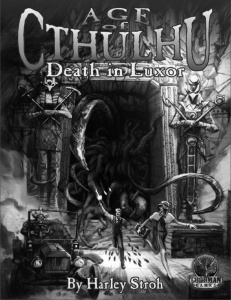 By Harley Stroh
By Harley Stroh
Published by Goodman Games; $12.95
Review by Matthew Pook
Death in Luxor is the first Age of Cthulhu scenario from Goodman Games, a publisher better known for its Dungeons & Dragons adventures. Set in Egypt in 1926, it is designed for relatively experienced investigators who possess archaeological or Egyptological experience or knowledge. It can be used to kickstart a campaign but is better added to an existing campaign, perhaps a classic such as The Complete Masks of Nyarlathotep or The Day of the Beast.
A telegram from Professor Aaron Bollacher, head of the University of Chicago’s Oriental Institute, summons the investigators to Luxor. He has discovered a new crypt at Medinet Habu, the Mortuary Temple of Rameses III, one which has clues that could reveal how the pharaoh was able to defeat the Sea Peoples. After a difficult arrival in Luxor, the investigators discover that the Institute has been ransacked, its staff and their families murdered, and the professor is dead by his own hand. The investigators must find out what happened at the Oriental Institute and why, before they become suspects themselves. Could the massacre be connected to Bollacher’s archaeological researches? This scenario quickly becomes a three-horse race to get to the site of an ancient evil before it is unleashed. Of course the investigators want to stop this, the cultists want to stop the investigators, and a group of occultists just want it under their control.
Comprising just five or six locations, Death in Luxor is strong in roleplaying and interaction with NPCs, though it is a pity that they are thrown away at the scenario’s action-orientated climax. Some players might decry the lack of traditional research needed, though there plenty of well-done clues to interpret, while others will relish the various combat scenes. Where Death in Luxor shines is in its strong plot and a background that nicely ties in Mythos elements with events in Egypt’s ancient past, both of which are strongly supported with excellent handouts and maps.
Where Death in Luxor disappoints is in its historical facts (suggesting that the investigators can fly to Egypt in 1926, for example) and other details (a bar stocks “bichor,” either a small fish or a town in India). The five pre-generated investigators are overly pulpy and the Call of Cthulhu rules are poorly applied throughout, the scenario lacking either Sanity losses or gains. Few of the NPCs are fully written up or have languages listed.
It is all too obvious that this is Goodman Games’ first scenario for Call of Cthulhu. It shows in the lack of historical and background detail, the poorly applied rules, and the lack of a map of the Oriental Institute’s dig site and the scenario’s McGuffin, an idol that the various parties are trying to acquire. For these reasons this is not a scenario for the neophyte; it needs an experienced Keeper to make it playable. The pleasingly pulpy plot gets it 3 phobias.
